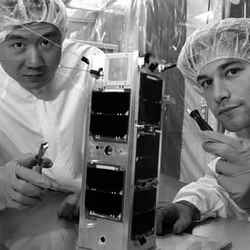
Prof. Robert Zee and Eric Caillibot put final touches on CanX-2. Image credit: U of T Click to enlarge
A 3.5- kilogram satellite that could revolutionize the space industry was unveiled Aug. 31 at U of T?s Institute for Aerospace Studies (UTIAS).
The Canadian Advanced Nanospace eXperiment 2 (CanX-2) satellite, which appears as unassuming as a shoebox, will pave the way for a wave of mini-satellites that are more effective and less expensive.
CanX-2 is the brainchild of graduate students and staff. Professor Robert Zee, manager of the institute?s space flight laboratory (SFL) and the CanX-2 team leader, said the point of the satellite mission is two-fold.
?The first is to provide complete development cycle training for students through a mission that has to be complete in two years,? Zee said. ?The second is to launch a tiny research platform into space to test innovative, revolutionary technologies in a rapid, risk-taking manner and also to perform important science missions that are now benefiting from the availability of smaller and smaller instrumentation.?
Set to launch next year, CanX-2 will test small, low-power devices such as a mini-spectrometer designed to measure greenhouse gases. Its primary goal is to lay the groundwork for flying formations of two similar but more advanced satellites.
These satellites, CanX-4 and CanX-5, will demonstrate technology that could eventually find large, expensive satellites replaced by groups of smaller, cheaper collaborating satellites. CanX-4 and CanX-5 are scheduled for launch in 2008.
?What we?re trying to prove here is that spacecraft don?t have to be huge and clunky to achieve the best results,? said Zee, who added that the price tag for the CanX-2 and two following missions is only $1 million, compared with hundreds of millions of dollars for a traditional satellite mission.
?These nanosatellites and the tiny technologies that we?re launching into space represent a paradigm shift in the way we think about and execute space missions.?
For students such as Daniel Kekez the chance to work on a real space mission is priceless. ?I?ve spent the past two years going from designs and calculations to building and testing hardware and software that will fly and operate in space,? Kekez said. ?This kind of experience would take years to obtain for an engineer starting out in industry. It?s simply fantastic!?
CanX-2 is the second nanosatellite mission at UTIAS/SFL. CanX-1, Canada?s first nanosatellite and one of the smallest satellites ever built, was launched with the MOST microsatellite in 2003 by Eurockot Launch Services from Plesetsk, Russia
Original Sourse: U of T News Release
